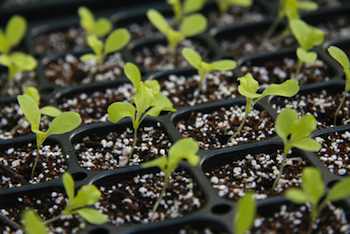By Sean Conway

Starting seed inside your home is easier than you think, and it vastly expands your options for garden plants
With so many gardens still buried under the snow and ice -- the frigid effects of which were felt as far south as Mexico -- it might be hard for many to get in the mood to start the seeds for their spring gardens. But that time is upon us.
For many novice gardeners, starting plants from seed is a bit of a mystery. For the last few decades, the trend has been for gardeners to buy plants from their local garden center or DIY store rather than starting their own from seed. But experienced gardeners know the advantages of buying seed: It saves you money, and it vastly expands the variety of options for your garden.
DIY stores and mass retailers buy their plants from commercial growers, who usually only supply the basics. That typically means the standard fare in vegetables, such as a few types of lettuce, a few varieties of tomatoes, and one or two types of peppers. Seed catalogs, on the other hand, offer gardeners pages of different choices for each type of vegetable, often selling heirloom varieties as well as new hybrids.
Starting seeds is easy -- provided you meet the requirements for the plants you want to grow. The hardest part is selecting from the abundance of interesting options!
Once you have selected your seeds, the next step is to figure out when to plant. First you'll need to find out the last expected frost date for your area. Frost dates are averages, and are provided as a range of dates. The best way to find this information is to contact your local agricultural extension service. In my Zone 6 garden, the last expected frost dates are listed as between March 30 and April 30. These are average dates, and as a rule of thumb I prefer to use April 30 to be on the safe side.
When you know your last expected frost date, check the information provided on your seed package to find out how many weeks prior to the frost date you should plant that particular seed. Counting back from the last expected frost date will provide you with a planting schedule.
Note that sowing schedules can vary widely depending on the type of seed involved. Artichokes, parsley and viola seeds may need to be sown as many as 12 to 14 weeks prior to the last frost, while pumpkins and squash may only need two to three weeks of lead time.
When growing from seed, planning ahead will help ensure success. Having all the necessary equipment such as soil, a watering can, and a designated area for seed trays will make the process fun instead for a chore.
Most seedlings have similar requirements: adequate light, proper temperature and proper moisture levels. Space tends to be the biggest problem for most seed growers. Fortunately, seedlings do very well under fluorescent grow lights, so you won't have to cram seed trays in every south-facing windowsill in the house.
If you've never grown your own plants from seed, a quick trip to the library or your local bookstore will provide all the information to get you started. Once you enter into the world of seed starting and realize how easy it is, you'll wonder why you didn't start earlier. This time honored tradition can turn an ordinary garden into an extraordinary one.
Sean Conway's book is "Sean Conway's Cultivating Life: 125 Projects for Backyard Living" (Artisan Books, 2009), describes 125 projects for backyard living.
Available at Amazon.com:
Cut Your Energy Bills Now: 150 Smart Ways to Save Money & Make Your Home More Comfortable & Green
It's Easy Being Green: A Handbook for Earth-Friendly Living
Sean Conway's Cultivating Life: 125 Projects for Backyard Living
Copyright ©, Cultivating Life by Sean Conway
AUTOS | HOBBIES | EDUCATION | FAMILY | FASHION | FOOD & RECIPES | HOME DECOR | RELATIONSHIPS | PARENTING | PETS | TRAVEL | WOMEN
Home & Garden - Key to Extraordinary Garden: Starting Your Own Seeds